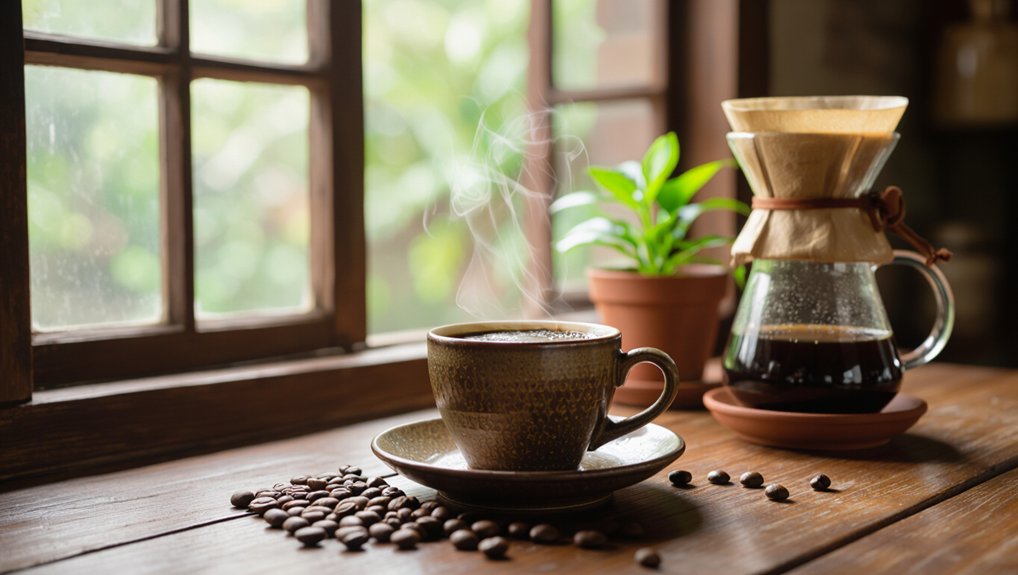Are you tired of the same old coffee routine and wondering what Thailand has to offer beyond tourist-trap café chains? Thailand’s coffee scene is experiencing a remarkable transformation, with specialty roasters and unique regional varieties gaining international recognition. Many coffee enthusiasts overlook this Southeast Asian gem, missing out on distinctive flavors that rival traditional coffee powerhouses.
This comprehensive guide will take you through Thailand’s diverse coffee regions, from the high-altitude farms of northern Chiang Mai to the volcanic soils of southern provinces. You’ll learn about the unique flavor profiles that make Thai coffee stand out, discover traditional brewing methods like the famous Thai iced coffee alongside modern specialty techniques, and understand how factors like elevation and processing methods create the complex taste experiences Thailand is becoming known for.
Whether you’re planning a coffee-focused trip to Thailand or simply want to expand your brewing knowledge at home, this post covers everything you need to know about Thai coffee culture, regional varieties, and the brewing methods that bring out their best characteristics.
Table of Contents
The Historical Journey of Coffee in Thailand
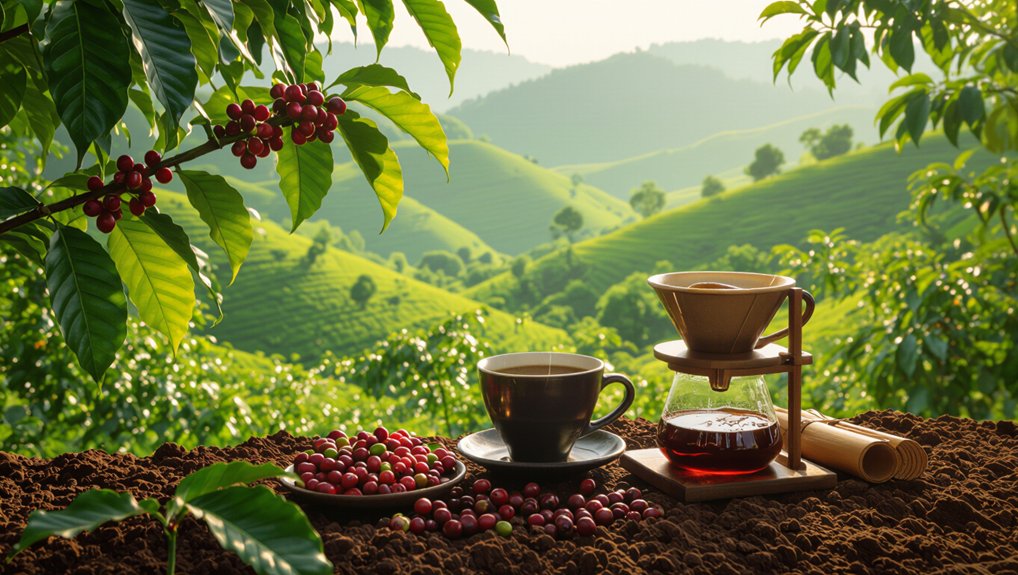
Although coffee might seem like a relatively recent phenomenon in Thailand, its roots stretch back to the late 19th century during the reign of King Rama V. He introduced coffee cultivation to diversify agriculture, initially focusing on Robusta beans in northern regions like Chiang Mai.
As Thai coffee farmers explored new territories, Arabica coffee emerged as a profitable crop, transforming the global coffee market. By 1976, Thailand began exporting coffee, marking a significant milestone in its coffee production history.
Today, specialty coffee from Thailand represents a testament to the nation’s agricultural innovation and commitment to quality brewing.
Exploring Thailand’s Coffee Growing Regions
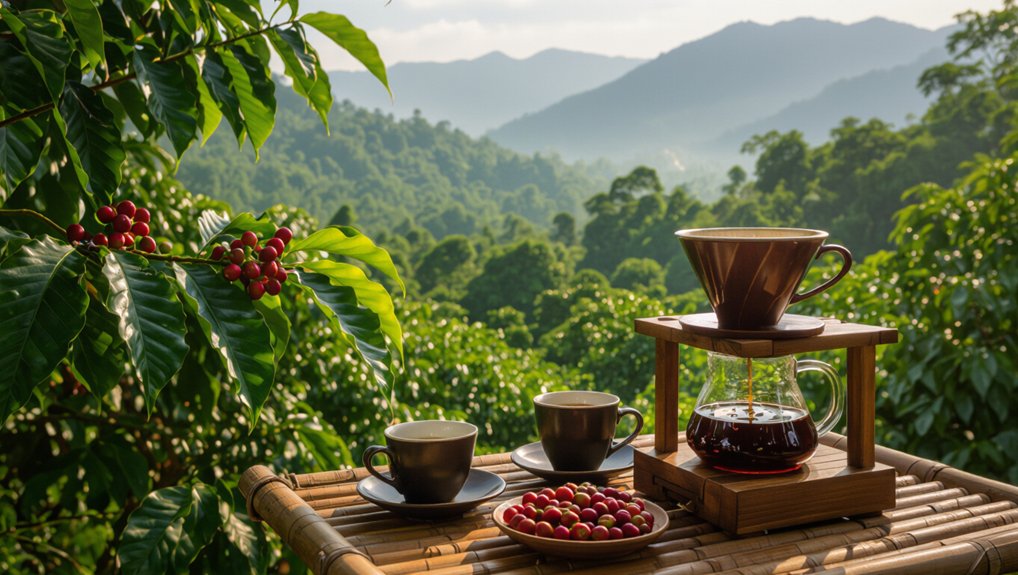
Building on Thailand’s rich coffee heritage, the country’s diverse landscape offers a fascinating tapestry of coffee-growing regions that’ll captivate any coffee enthusiast.
Northern Thailand, especially Chiang Mai, boasts remarkable Arabica coffee farms producing beans with bright citrus notes and chocolatey richness. These high-altitude coffee regions, nestled between 800-1,200 meters, deliver unique flavors that reflect the terrain’s organic farming practices.
In contrast, southern provinces like Chumphon cultivate robust Robusta beans, offering bold, full-bodied profiles that showcase Thailand’s coffee diversity.
Whether you’re exploring northern mountain slopes or southern plantations, you’ll discover a rich Thai coffee culture waiting to be savored.
Arabica and Robusta: A Tale of Two Varieties
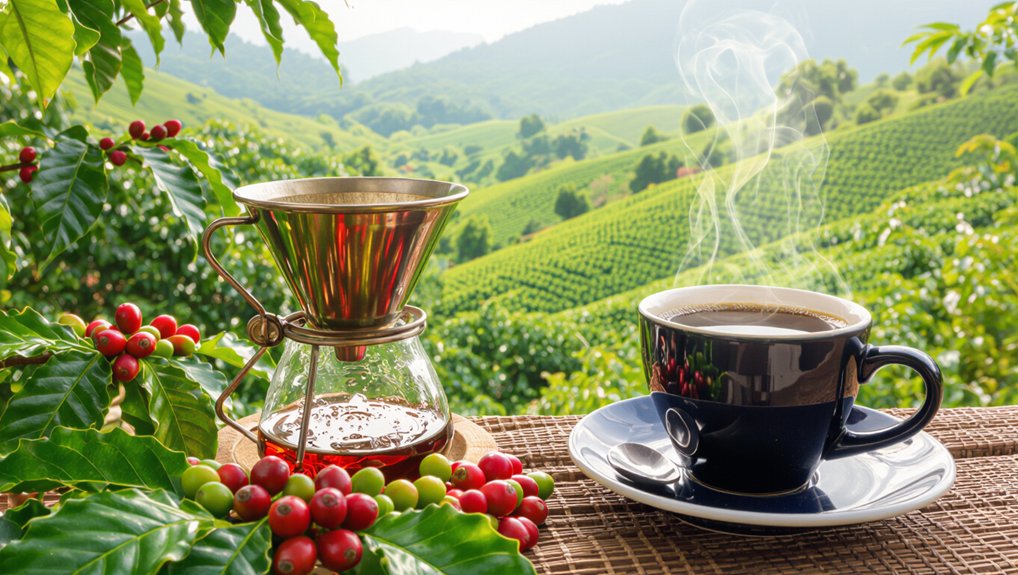
How do two distinct coffee varieties shape Thailand’s rich coffee landscape?
In Chiang Mai’s northern regions, Arabica beans thrive at elevations between 800-1,200 meters, offering a mild flavor profile with moderate acidity.
Meanwhile, southern provinces cultivate Robusta coffee beans, known for bold, earthy tastes.
Coffee farming here showcases unique flavors of Thailand through traditional techniques used in specialty coffee scenes.
Typica and Catimor Arabica varieties deliver smooth, nuanced notes, while Robusta provides intense, robust characteristics.
This diversity means you’ll experience a remarkable range of tastes, reflecting Thailand’s complex coffee heritage.
Flavor Profiles and Unique Characteristics
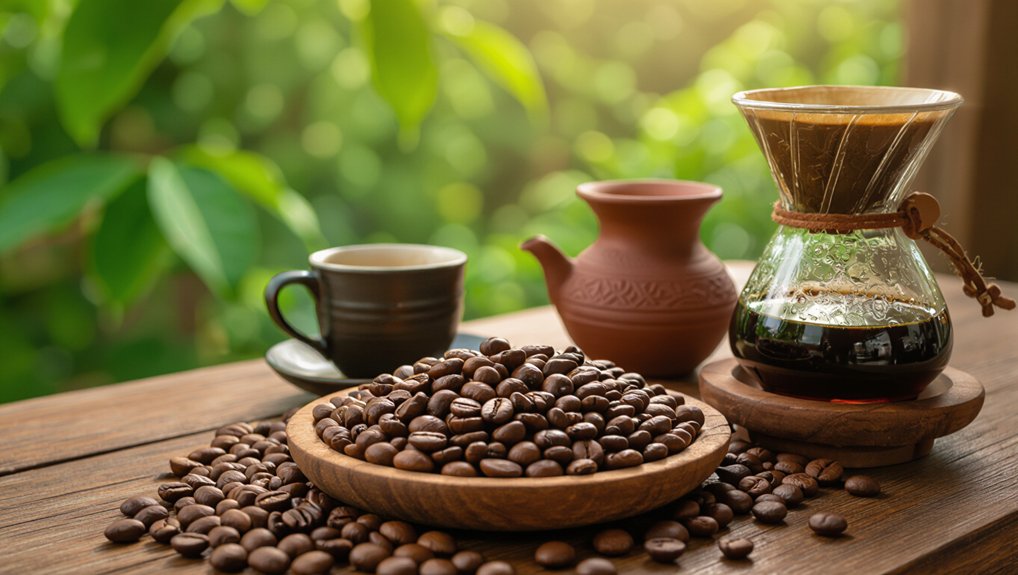
Every coffee lover will be captivated by the extraordinary flavor landscape of Thai coffee, a sensory journey that reflects the country’s diverse agricultural regions and rich coffee heritage.
Dive into the unique characteristics of Thai coffee through these flavor highlights:
- Thai Arabica from Chiang Mai offers bright citrus notes
- Northern regions deliver a chocolatey finish with subtle complexity
- Traditional processing methods create balanced flavor profiles
- Peaberry varieties provide concentrated, rich aromatic experiences
- Elevation and climate contribute to distinctive taste variations
These nuanced characteristics make Thai coffee a remarkable exploration of terroir and craftsmanship, promising an unforgettable brewing adventure.
Sustainable Farming Practices
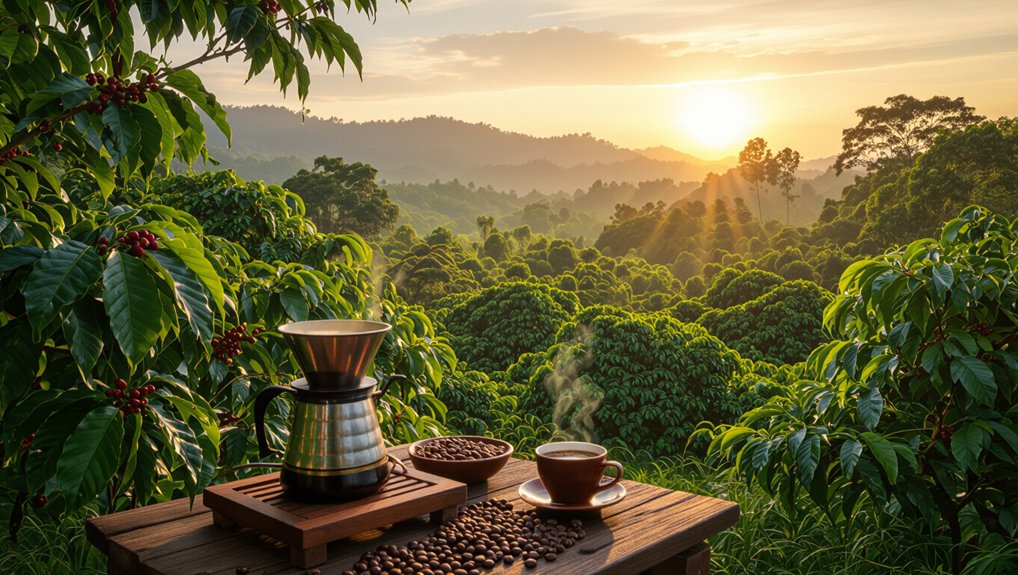
Because sustainability has become a cornerstone of modern coffee production, Thai coffee farmers are revolutionizing agricultural practices that protect both the environment and local communities.
They’re embracing organic farming methods and shade-grown coffee techniques that minimize environmental impact while preserving biodiversity.
Fair Trade programs support these small, family-owned farms, ensuring local farmers receive fair compensation for their high-quality beans.
Traditional and Modern Brewing Techniques
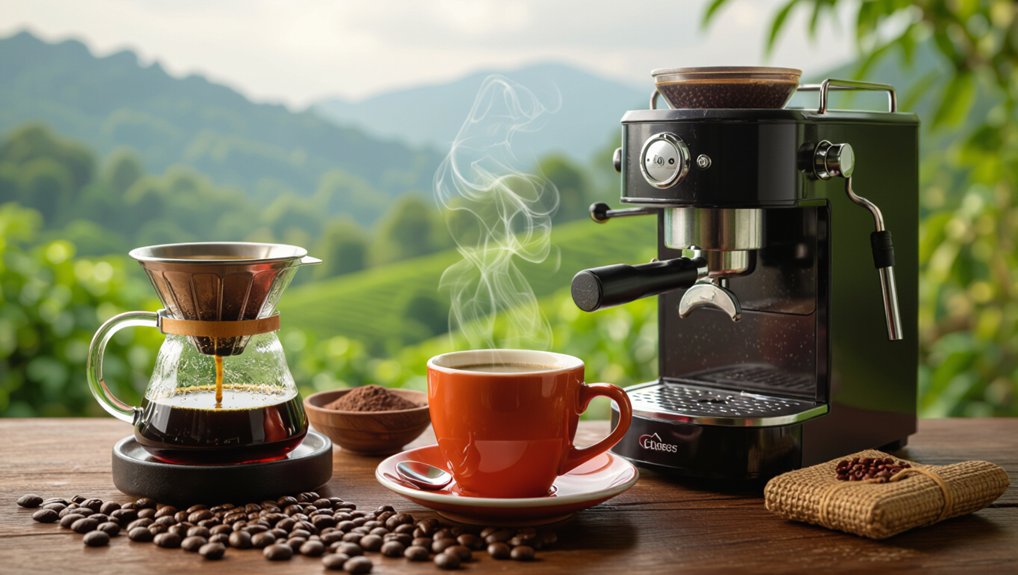
When exploring the rich tapestry of Thai coffee culture, brewing techniques emerge as a fascinating blend of tradition and innovation.
My journey through Thai coffee reveals a vibrant landscape of flavor profiles and brewing methods:
- Traditional Phin filter creates intensely strong Robusta-based coffee
- Kafe Boran espresso showcases slow-brewed, rich crema techniques
- Oliang (iced coffee) delivers bold, sweetened refreshment
- Modern pour-over methods highlight Arabica’s complex notes
- Specialty coffee scene continually evolves brewing approaches
These techniques transform Thai coffee from simple beverage to an artisanal coffee experience, bridging time-honored traditions with contemporary craftsmanship.
Thai Coffee in the Global Market
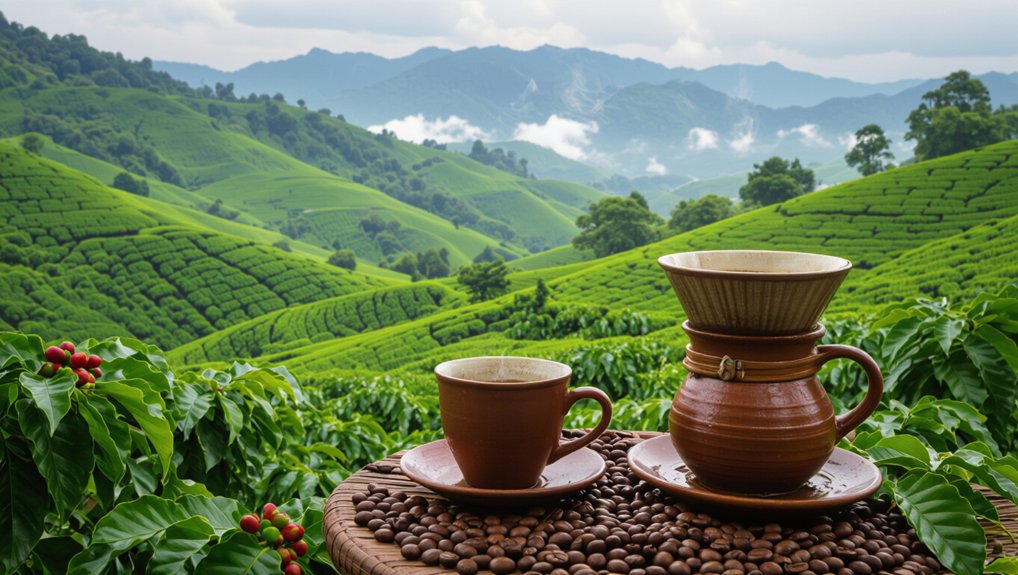
As Thai coffee continues to make waves in the international marketplace, its journey from local plantations to global shelves represents a remarkable transformation of the country’s agricultural landscape.
Chiang Mai’s Arabica beans, with their distinctive chocolate notes, are capturing attention in the global coffee market. Sustainable farming practices and innovative brewing techniques have positioned Thai coffee as a premium product, featuring both Robusta and Arabica varieties.
These carefully cultivated coffee exports showcase Thailand’s commitment to quality, attracting specialty coffee enthusiasts worldwide who appreciate the nuanced flavors and ethical production methods emerging from this dynamic coffee-producing nation.
The Cultural Significance of Coffee in Thailand
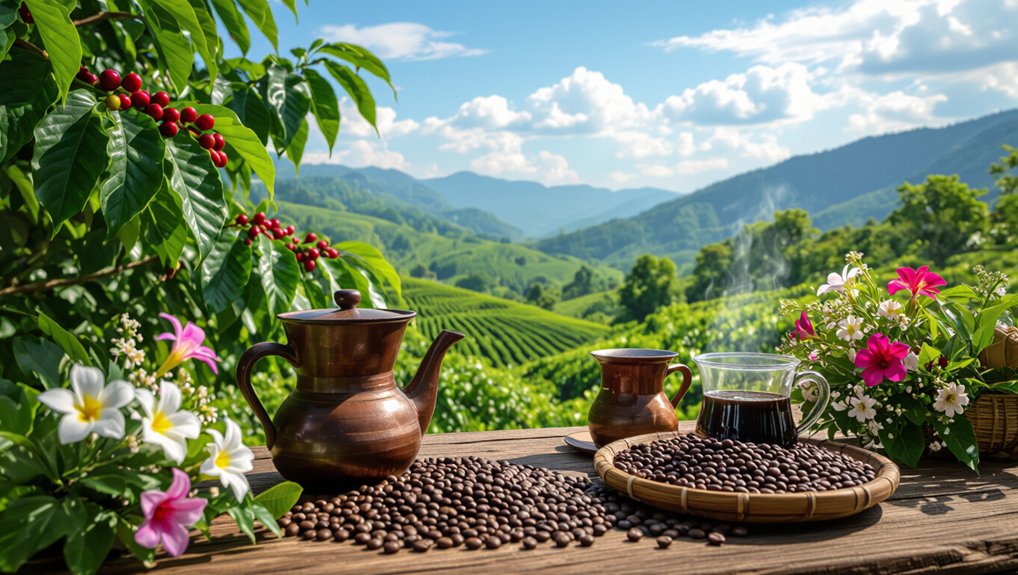
Though coffee might seem like a mere beverage, in Thailand, it’s a vibrant cultural tapestry woven through generations of agricultural heritage and social connection.
In Chiang Mai and the northern regions, coffee embodies local traditions and community practices:
- Family-owned farms prioritize organic farming methods
- Markets serve as social connectors over steaming cups
- Thai coffee production blends traditional and modern techniques
- Coffee reflects the economic and social fabric of rural communities
- Each brew tells a story of cultural significance
These elements transform coffee from a simple drink into a profound cultural experience that connects generations and celebrates Thai agricultural ingenuity.
Frequently Asked Questions
What Are the Different Types of Thai Coffee?
I’ll share the types of Thai coffee: Arabica (Typica, Catimor, Thai Geisha) from the north, Robusta from the south, and unique Peaberry – each offering distinct flavors from bright citrus to bold, earthy notes.
What Kind of Coffee Is Grown in Thailand?
I grow two main types of coffee in Thailand: Arabica in the northern highlands like Chiang Mai, with its mild flavor, and Robusta in the southern regions, known for its bold, full-bodied taste.
Why Does Thai Coffee Taste Different?
I’ll explain why Thai coffee tastes different: it’s due to unique terroir, diverse growing regions, distinctive processing techniques, traditional brewing methods, and varied climatic conditions that create complex, nuanced flavor profiles unlike other coffees.
How Is Coffee Made in Thailand?
I carefully hand-pick ripe coffee cherries, then process them using traditional wet or honey methods. After sorting and fermenting, I sun-dry the beans, roast them locally, and brew using a classic Phin filter to capture Thailand’s unique coffee essence.
In Conclusion
Thailand’s coffee journey is a vibrant tapestry of tradition and innovation. From the misty northern highlands to the lush southern farms, I’ve discovered a world of flavors that’ll captivate any coffee lover. Sustainable practices, unique processing methods, and a deep cultural connection make Thai coffee more than just a drink—it’s an experience that bridges community, craft, and passion. Each sip tells a story of dedication and pride.

